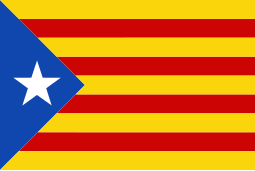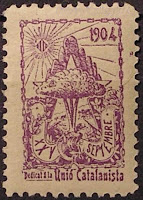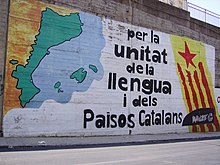用戶:Simon 1996/沙盒11
 | |
| 別名 | Estelada Blava、Flag of Catalan separatism |
|---|---|
| 用途 | 民用旗(陸) |
| 比例 | 2:3 |
| 設計者 | Vicenç Albert Ballester |
孤星旗(Estelada) (東加泰羅尼亞語:[əstəˈɫaðə], 西加泰羅尼亞語:[esteˈlaða]; pl. Estelades; full name 孤星令旗、"starred旗"或"孤星旗", from estel, "star") 是加泰羅尼亞獨立運動非官方旗幟,他們支持加泰羅尼亞或加泰羅尼亞語地區 (加泰地區, i.e. the territories where Catalan is traditionally spoken)獨立 。這旗幟是1970年代西班牙轉為民主以來加泰羅尼亞民族主義者使用最顯著抗爭標誌的旗幟。
The design of the Estelada comprises the red-and-yellow bars of the 令旗, with the addition of a five-pointed star in a triangle at the hoist.
Design and meaning
[編輯]
The flag dates from the early 20th century; it was most probably designed in 1918 by Vicenç Albert Ballester i Camps.[1] It came from combining the traditional four red stripes over a yellow field of the Senyera with a blue triangle at the hoist containing a five-pointed white star, inspired by the flags of Cuba and Puerto Rico. Later designs combine the Senyera with a yellow triangle at the hoist containing a five-pointed red star. In both designs the lone star motif means Catalan independence.
History
[編輯]




The 3rd Article of the provisional Constitution of the Catalan Republic, written and approved in 1928 in Cuba by the Assemblea Constituent (Constituent Assembly) of Catalan separatism, specifically provided that the official flag of the Catalan Republic should consist of four red bars on a yellow field, superimposed with a white five-pointed star in a blue triangle.
The star in the flag comes from the early days of nationalism, the lone star symbolising national freedom and independence. Cuba's fight for its independence was watched closely by the Catalanists of the nineteenth century and in 1906, when the Cuban War of Independence ended, the Centre Catalanista de Santiago de Cuba (Catalanist Centre of Santiago de Cuba) was created. An embryonic Catalan estelada flag could already be seen: in the middle of a senyera there was a white star with five points.
The first star with a clear nationalist intent known in Catalonia is from before 1904, associated with the Unió Catalanista (Catalanist Union). It is a stamp commemorating the acquisition of the Pi de les Tres Branques (Three-Branched Pine) by the Catalanist Union.
Later, in 1906, a star appeared in the nameplate of the magazine Fora Grillons! (Breaking Chains!), published in Santiago de Cuba by Catalan exiles - a publication that had already clearly proclaimed the independence of Catalonia.
During the twenties, once the First World War was over, Europe saw a wave of new nation-states being created, with the assistance of President Woodrow Wilson.
The politics of the League of Nations allowed many nations to seize the opportunity of independence, and Czechoslovakia, Finland, Estonia, Latvia, Lithuania and Armenia did so in 1918; other nations like Ukraine, Belarus and Georgia, were declared independent, but were then immediately annexed by the Soviet Union.
From the nations that hoped for independence, pressure groups began to mobilize internationally. In the Catalan case, the Comitè Pro-Catalunya (Pro-Catalonia Committee) was one of the most active. It was in this context that a need was perceived to have a flag as a symbol of Catalan aspiration; and, of course, a star appeared on it. Since then the estelada flag began to be spoken of. It was probably designed by Vicenç Albert Ballester, with the blue triangle signifying the blue sky of humanity, and the white star symbolizing freedom.
The first photograph in which the flag appeared was in a publication dated the bulletin L』intransigent (The Intransigent) in 1918. It shows a group of young Americans and Catalan separatists holding both flags.
Also in 1918, there was a comic strip in circulation—a stamp without postal value—dedicated to the future Society of Nations, where there was also an estelada.
There are several kinds of estelada. One is in the last number of La Tralla ("The Whip", a radical separatist magazine from the 1920s), before the coup d'état by Miguel Primo de Rivera. The other is in a document published by the Comitè Pro-Catalunya written in Catalan and Arabic, to greet and encourage one of the Moroccan leaders who revolted against Spain.
In Cuba, it appeared for first time in the nameplate of the magazine La Nova Catalunya (1920), (The New Catalonia). The estelada flag went on to appear in other Catalan separatist publications.
An estelada was owned by Francesc Macià during the failed invasion of Prats de Molló in 1926; it appeared between the imprisonment of the Catalan volunteers and their transfer to Paris to be put on trial. There are photographs of the volunteers with the estelada in several other places.
In 1928, with the presidency of Francesc Macià in the Constituent Assembly of the Catalan independence movement, the estelada was again seen, and the Catalan separatists made it their flag.

During this period a new practice began, and continues to the present day; whenever a prominent Catalan nationalist dies, as a sign of mourning, his comrades will cover the red bars of the estelada with a black cloth, leaving the star visible to signify that they will continue pursuing the same ideals.
Later, during the period from 1931 to 1936, the estelada still appears numerous times. Some of these flags only have two colours due to the shortage of money, but the traditional estelada with the blue triangle and white star was kept.
After the Francoist dictatorship came to power, the Front Nacional de Catalunya (National Front of Catalonia), or FNC, which used the Catalan flag and the estelada, was formed in response to the new Spanish nationalist regime.
During the sixties, in the university section of the FNC, there was a faction called the Partit Socialista d』Alliberament Nacional dels Països Catalans, (Socialist Party for the National Liberation of the Catalan Countries), or PSAN. Because this party wanted to make its own socialist and Marxist ideas clear, it decided to change the colour of the star to red; in 1969, this new version of the estelada started to appear at PSAN meetings.
In the mid-seventies, the PSAN had, in turn, its own splits. They led to the creation of a new movement, the Moviment d』Unificació Marxista (Movement of Marxist Unification), which started to use the red star inside a white triangle, while the PSAN kept the red star inside a yellow triangle.
The unification of the two versions of the flag could only take place when the Movement of Marxist Unification and the Bloc d』Esquerra d』Alliberament Nacional (Left National Liberation Bloc), or BEAN, both disbanded. At that time the flag with the red star and the yellow triangle were a symbol of both socialist and communist separatists.
Present-day use
[編輯]
As of 2005 both kinds of Estelada flag (the classic and the red) are used at the same time.
After the Fall of Communism in Europe the red star of the Estelada groga (yellow estelada) has steadily lost its original leftist meaning. It is currently flown just as a simpler and less cluttered version of the Estelada in the traditional Catalan colors.[來源請求]
The estelada is ubiquitous as a simplified symbol - four vertical bars topped by a star, sprayed or daubed on walls, lampposts or mailboxes all over Catalonia. These simple graffiti are most often in one basic color, either in black or red. More elaborate large pro-independence graffiti use often the red-star Estelada as a symbol.[來源請求]
In 2016, the Spanish government prohibited football fans from bringing esteladas to the Copa del Rey final match between Barcelona and Sevilla, held in Madrid. The government applied the article 2.1 of the Law on Sports, which prohibits the display of symbols that "incite, foment or help violent or terrorist behavior."[2] A Madrid judge overruled the ban after Barcelona complained, citing freedom of expression.[3]
Valencian nationalist Senyera
[編輯]The Valencian nationalist Senyera, also known simply as Estrelada, is a flag of Valencia that evolved from the flag of the city of Valencia based on the former Catalan Estelada.
The white star version has been used by Valencian nationalist groups since the early 20th century. Some of these groups may be blaverist (Valencian separatist, as opposed to Catalan nationalist) in their ideology, especially those with more pro-sovereign positions.
The oldest extant document showing this Estrelada - with a red star - is a war poster of the Valencian Left.
Other Estelades
[編輯]
|

|

|

|

|
|---|---|---|---|---|
| Aragon | Galicia | Asturias | Canary Islands | Andalusia |
Since its creation, various Estelades, or Estrelades (such as the Andalusian, Aragonese or Galician separatist flags.) have been adopted by separatist movements within Spain.
參考資料
[編輯]- ^ Vicenç Albert Ballester i Camps. Grup Enciclopèdia Catalana. [23 August 2015].
- ^ Luis F. Durán. No se permitirá entrar con banderas esteladas a la final de la Copa del Rey. El Mundo. 18 May 2016 [20 May 2016] (spanish).
- ^ Barcelona fans allowed to bring Estelada flags to Copa del Rey final. BBC. 20 May 2016 [25 May 2016].
延伸閱讀
[編輯]- Joan Crexell i Playà, L'origen de la bandera independentista, Edicions El Llamp, 1984.
外部連結
[編輯]- (加泰隆尼亞文) 100th anniversary of estelada flag
- (加泰隆尼亞文) History of the estelada flag
- (加泰隆尼亞文) Estelades gallery


